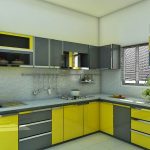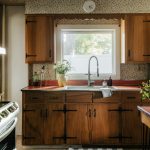Designing a kitchen floor plan involves more than just deciding where the sink and refrigerator should go. It’s about creating a layout that works for your lifestyle, your house, and most importantly, your comfort. An essential aspect of this design process can include the integration of a mudroom. A well-thought-out mudroom can be a lifesaver, serving as a transition space between the outdoors and indoors, providing room for storage, and reducing clutter throughout your home.
However, fusing a mudroom with a kitchen calls for a certain level of finesse. The key is to create a blend that is functional, efficient, and visually pleasing. With the right tips and professional advice, this task is achievable. Let’s delve into the specifics of how you can design a seamless kitchen floor plan that includes a mudroom integration.
In parallel : What are the best soundproofing methods for noisy kitchen appliances?
Planning Your Kitchen-Mudroom Design
Before you begin to move things around and make any drastic changes, you need to have a clear plan. The planning phase is crucial in any design project. If you want a kitchen and mudroom that work both in harmony and independently, you need to consider several factors.
Firstly, think about how you and your family use your kitchen and what you want from your mudroom. For instance, do you want your mudroom to act as a buffer zone, a laundry room, or simply a space where jackets and boots can be stored? This will influence the design elements you’ll incorporate.
Additional reading : What are the best countertop edge styles for minimizing spills?
Next, consider the available space and how best to utilize it. This includes determining the best layout for your kitchen, considering the workflow, and how the mudroom will be integrated. To help you out, you may want to consider seeking the advice of professional contractors or interior designers.
Choosing the Right Cabinets and Storage Options
Storage is one of the most important aspects to consider when designing a kitchen-mudroom integration. Your choice of cabinets should offer adequate storage while also complementing the overall design of the space.
For the kitchen, consider a mix of lower cabinets with pull-out drawers for pots and pans and upper cabinets for dishes and glassware. Additionally, a pantry cabinet can be a great addition for storing food items and small appliances out of sight.
In the mudroom, hooks for hanging coats and bags, cubbies or lockers for shoes and boots, and drawers or baskets for smaller items like gloves and hats can be ideal. A bench is also a practical and stylish addition to any mudroom, providing a place to sit while putting on or removing shoes.
Incorporating the Right Flooring and Tile
Flooring plays an essential role in the design of your kitchen and mudroom. It needs to be durable, easy to clean, and fit with the overall design aesthetic. Tile is a popular choice for both kitchens and mudrooms due to its durability and variety of design options.
In the kitchen, you might opt for a simple white subway tile for a clean, classic look, or a colorful mosaic tile for a bolder, more custom design. For the mudroom, consider a darker tile to hide dirt and stains. Non-slip options are also important for this space, as it will likely get wet and muddy.
Selecting the Best Lighting and Wall Colors
Lighting and color are key elements that can make a big difference in how your kitchen and mudroom integration looks and feels. For the kitchen, you’ll want plenty of lighting for cooking and a warm, inviting color on the walls.
Recessed lighting or a central ceiling light coupled with under-cabinet lighting is ideal for ensuring that all work surfaces are well lit. For the wall color, consider a warm white or a subtle color that complements your cabinets and countertops.
In the mudroom, a durable paint in a cheerful color can make the space feel welcoming and hide dirt and scuffs. Good lighting is also essential in this area, especially if it’s a space where you’ll be doing laundry or searching for lost mittens and hats.
Factoring in Custom Elements
Sometimes, a successful kitchen-mudroom integration requires some custom elements. These could include built-in benches, custom storage solutions, or unique lighting fixtures that tie the two spaces together.
For instance, bespoke cabinets or shelving units can maximize storage in awkward corners or tight spaces. A customized bench can be built to the perfect height for your little ones. Custom elements can give your space that personal touch, making it truly tailored to your family’s needs and lifestyle.
Integrating a mudroom into your kitchen floor plan is not just a design trend, it’s a lifestyle choice. By following this guide and paying attention to each element of design, you can create a functional and beautiful kitchen-mudroom integration. Remember to always take into account your individual needs, the layout of your home, and of course, your personal style.
Considering Traffic Flow and Accessibility
While designing your kitchen-mudroom integration, it’s essential to think about the traffic flow. Considering how people move through and use these spaces can significantly influence your layout and design choices. A good rule of thumb is to keep high-traffic areas clear and accessible.
In the kitchen, prioritize accessibility to the sink, stove, and refrigerator. These areas, often referred to as the kitchen triangle, should be easily accessible without too many obstructions. Think about the placement of your kitchen island or dining table, ensuring they don’t block access to these key areas.
The mudroom serves as a transitional space, so it’s crucial to make it easy to navigate, especially when carrying groceries or other items into the house. Ideally, the mudroom should have a clear path to the kitchen and other parts of the house. Consider the placement of storage units and benches in the mudroom. They should be conveniently located but not hinder movement through the space.
In addition to traffic flow, consider the accessibility needs of all members of your household. This might mean having lower hooks and storage for younger children in the mudroom or having adjustable height counters in the kitchen for wheelchair users. These considerations can go a long way in ensuring your kitchen-mudroom design is both practical and inclusive.
Conclusion
Designing a kitchen floor plan that includes a mudroom integration can be a rewarding process. It’s all about creating a functional, efficient, and aesthetically pleasing space that caters to your lifestyle and needs. From the planning phase, through selecting cabinets and storage options, to choosing flooring and tiles, lighting and color, and considering traffic flow and accessibility, each step is important.
Remember, your kitchen-mudroom integration should be a reflection of you and your family’s lifestyle. Whether you need a mudroom that doubles as a laundry room, or you want a kitchen that’s a culinary haven, these spaces need to work for you.
Don’t shy away from incorporating custom elements into your design. These personalized touches can truly transform your space making it unique and tailored to your needs.
Finally, remember that professional advice can be invaluable. Interior designers and contractors can provide expert guidance and help you avoid common pitfalls. With careful planning, thoughtful design, and a little creativity, your kitchen-mudroom integration can become a beloved and functional part of your home.






